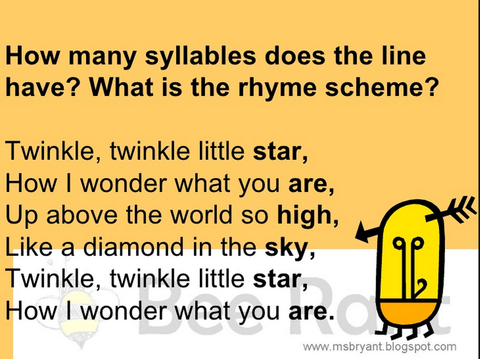Understandings
1. Students will recognise and understand poetry has a form of artistic expression and that different types of poetry have different structures.
2. Students will recognise and understand that poetry expresses and evokes different emotions by using sensory images, movement, sound, voice, etc.
3. Students will recognise and understand that poetry is written in specific structure, every aspect of a poem has a purpose.
Essential Questions
1. What is Poetry? What are the different types of poetic forms?
2. How do you read a poem? How do you make sense of poetry?
3. How do you write a poem? What are the rules that apply to the different forms of poetry?
|
|
|
What is a poetic device?
A poetic device is a plan or method of arranging words that allows poets to express themselves to their readers. There are many different poetic devices, but we will be focusing on these eight:
Alliteration
Personification
Similes & Metaphors
Hyperbole
Rhyme Scheme
Theme & Voice
Alliteration
Alliteration is the repetition of sounds at the beginning of words. A common example is the tongue twister "Peter Piper picked a peck of pickled peppers." In this case, the "p" sound came at the beginning of most of the words in the sentence.
We see alliteration in this excerpt from Edgar Allen Poe's classic poem The Raven. The examples of alliteration are underlined (note that "quaint" and "curious" count as alliteration because even thought they do not begin with the same letter, they begin with the same sound.) Click on Poe's photograph if you want to hear the poem being read aloud. Can you find the alliteration more easily when you hear the poem spoken out loud?
The Raven
"Once upon a midnight dreary, while I pondered, weak and weary,
Over many a quaint and curious volume of forgotten lore,
While I nodded, nearly napping, suddenly there came a tapping,
As of some one gently rapping, rapping at my chamber door.
"'Tis some visitor," I muttered, "tapping at my chamber door -
Only this, and nothing more."
Ah, distinctly I remember it was in the bleak December,
And each separate dying ember wrought its ghost upon the floor.
Eagerly I wished the morrow; - vainly I had sought to borrow
From my books surcease of sorrow - sorrow for the lost Lenore -
For the rare and radiant maiden whom the angels name Lenore -
Nameless here for evermore."
Rhyme scheme is a poet's deliberate pattern of lines that rhyme with other lines in a poem or a stanza. The rhyme scheme, or pattern, can be identified by giving end words that rhyme with each other the same letter.
Rhyme Scheme of Twinkle Twinkle.
The rhyme scheme of this poem can be determined by looking at the end word in each line.
The first line ends in the word 'star,' and the second line ends in the word 'are.' Because the two words rhyme, they are both given the letter 'A.' 'A' signifies that we have found the first rhyme in the poem. The third line ends in the word 'high,' and the fourth line ends in 'sky.' These two words don't rhyme with the first two words, 'star,' and 'are,' so they get the letter 'B.' So far, we have a rhyme scheme of 'AABB.'
The fifth ending word is a repeat, 'star,' and so is the sixth end word, 'are.' So, both of those words get the letter 'A,' as well. The rhyme scheme for this stanza, or first 'paragraph' of the poem is: AABBAA.
Sarah Cynthia Sylvia Stout Would Not Take the Garbage Out
Your browser does not support viewing this document. Click here to download the document.


